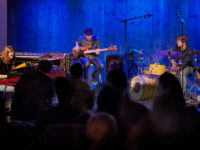Photos: Peter Figen
About three years ago I received a CD called Real And Imagined by jazz pianist and composer Kait Dunton, which came out of nowhere and just blew me away. The disc has found a permanent place in my car and I still pop it into the CD player a few times a year.
Since we last caught up with Ms. Dunton, this graduate of University of North Texas’s prestigious music program has been gunning for yet another advanced music degree at yet another top-notch music program at the University of Southern California. There, she’s picked up a few more fans from those she’s studied under, like noted jazz keyboardist and chair of USC’s Jazz Studies Alan Pasqua and fellow professor and drumming legend Peter Erskine. She brings this extra four years of classroom and performance seasoning to her latest progress report, the long awaited follow up CD Mountain Suite.
Mountain Suite isn’t Real And Imagined, Part II, as Dunton isn’t standing still: she is a student of the jazz art form in the very literal sense. Gone are much of the abrupt, dramatic turns and the fun friskiness that gave the earlier record its charms. In its place is greater emphasis on extended melodies, subtle maneuvering in place of exclamatory expressions and tighter integration among all the performers. Befitting the title of the album, the music is airier, more serene and more nuanced. If they made you think that this shares some similarities to an ECM recording, you wouldn’t be terribly far off, but there’s a classic Blue Note presence lurking, too.
All the supporting musicians on the new album are faculty members at USC’s Thornton School of Music. Joining Dunton are Erskine, Yellowjackets tenor man Bob Mintzer, bassist Darek “Oles” Oleszkiewicz (Brad Mehldau, Billy Higgins, Pat Metheny, Joe Lovano, Eddie Henderson, Charles Lloyd, John Abercrombie, Bennie Maupin, etc.) and trumpet player John Deversa, (John Daversa Progressive Big Band). The presence of the two horn players on five of Dunton’s nine originals puts her in the accompaniment role more often — another distinction of her second album — and a role she fills in rather well.
“Day One” opens the album in a low key manner, a prelude that makes way for the “Path,” where we hear for the first time an arrangement of horns that flesh out the harmonics in Dunton’s compositions probably a little better than what can be done by piano alone. Mintzer’s thoughtful, subdued solo signals a set that won’t be a blowing session, but instead a pensive exploration of the harmonies Dunton has put before them. Daversa’s breathy tone and measured delivery also makes him a prime fit for the material, and he dishes out highlights on selections such as the urbane, elusive “Return.”
The friskiness that established the character of “Real And Imagined” isn’t entirely removed; “Frolic” (video above) is the album’s best rendering of her trio mode, a breathtaking, dancing sprint from one idea to another and back again. Erskine never threatens to dominate his pupil, but as the consummate pro, he doesn’t need to in order make his presence felt. His world class feel for the melody and cadence locks in on Dunton’s multi-faceted melodies and bolsters them.
I think that years down the line, Mountain Suite will be looked at in retrospect as another stop along the way in the very promising career of Kait Dunton, but it’s a transition point that is already further along than the destination for many good jazz musicians. In the company of some mighty elite and well-established players, she is able to fit right in and project the confidence and growth that will undoubtedly serve her well in the next phase of her career.
Mountain Suite was self released last April 4. Visit Kait Dunton’s website for more info.
[amazon_enhanced asin=”B007UCNJ4K” /] [amazon_enhanced asin=”B0018YDPOU” /] [amazon_enhanced asin=”B003PNG65M” /] [amazon_enhanced asin=”B001916SJG” /] [amazon_enhanced asin=”B007UCNKJ4″ /]
- Claudio Scolari Project – ‘Bloom’ (2025) - June 12, 2025
- Denny Zeitlin – ‘With a Song In My Heart: Exploring The Music of Richard Rodgers’ (2025) - June 4, 2025
- Ches Smith Quartet – ‘Clone Row’ (2025) - May 30, 2025




